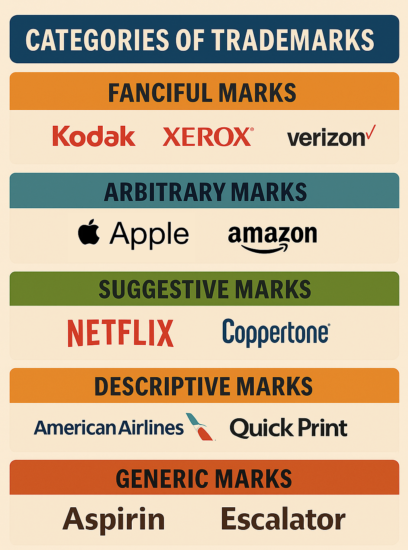
When launching a new product, service, or business, you should create a brand around it and protect that brand. It is a worthwhile exercise to familiarize yourself with the different types of trademarks available under trademark law. Whether you're naming a new streaming service, labeling an actual product, or identifying your business name, selecting the right kind of trademark is key to securing brand protection and avoiding infringement.
This guide breaks down the main types of trademarks, using accessible language for entrepreneurs and small business owners unfamiliar with legal jargon. By the end, you’ll understand how to choose an appropriate mark for your brand, avoiding problematic marks such as generic terms. We also provide a brief discussion of the trademark registration process with the United States Patent and Trademark Office (USPTO).
A trademark is a word, phrase, symbol, or design, or any combination of those things that identifies and distinguishes the source of the goods from other sources of goods. In other words, a trademark distinguishes one provider of goods from another (e.g., Coach from Louis Vuitton). Think of a trademark as your brand’s signature. It helps customers recognize your company and its offerings.
Under U.S. trademark law, trademarks can be words, letters, logos, or even non-traditional marks like sounds, colors, or smells. They must be distinctive enough to differentiate your specific brand from others in the marketplace.
Service marks are essentially the same as trademarks, except that service marks are used in connection with services rather than goods. For example, the Federal Express company does not sell goods, it sells package delivery services in connection with the FedEx® mark. Thus, the FedEx® mark is a service mark.
Not all marks are created equal. The more distinctive a trademark is, the stronger the legal protection it provides. Trademark law recognizes a spectrum of distinctiveness that determines the strength of a mark and the level of protection it provides. The more distinctive a mark is, the more protection it receives. Let’s look at the five primary categories:

Fanciful trademarks are completely invented or coined terms with no prior meaning in any language. These are not real words until a business or organization creates and uses them as a mark. Because they have no preexisting definition or association with a type of product, service, or industry, fanciful marks are considered the strongest type of trademark under U.S. law. This category is also referred to as “coined marks” or “invented words.”
Fanciful trademarks are inherently distinctive, which means they are eligible for registration and legal protection without the need to prove acquired distinctiveness. Acquired distinctiveness is secondary meaning that is established in the mind of the consumer over time through advertising under the trademark and presence in the marketplace. The inherent distinctiveness of fanciful marks makes it much easier to enforce trademark rights against infringing third parties.
Well-known examples of fanciful trademarks include Kodak®, Xerox®, Exxon®, and Verizon®. None of these words existed before they were adopted by companies to identify their goods or services. Today, these names are strongly associated with a single source of goods or services, providing clear and powerful brand recognition.
Fanciful marks receive the highest level of protection. They are typically not vulnerable to claims of descriptiveness, nor are they likely to be confused with other existing marks, given their uniqueness. This makes them ideal candidates for federal registration and long-term legal protection.
Businesses that want to create a memorable and legally defensible brand should strongly consider a fanciful trademark. While such marks may initially require more effort and marketing to build consumer recognition, the long-term benefits in terms of exclusivity, trademark protection, and market clarity are substantial.
Arbitrary trademarks consist of real, commonly known words that are used in a way entirely unrelated to their ordinary meaning. Unlike fanciful trademarks—which are completely invented—arbitrary marks take existing dictionary words and apply them to goods or services with which they have no logical or descriptive connection. This disconnect between the mark’s usual definition and the product it represents makes the mark distinctive and highly protectable.
Arbitrary trademarks are also considered inherently distinctive, placing them near the top of the trademark protection hierarchy. They are eligible for federal registration with the United States Patent and Trademark Office (USPTO) and do not require a showing of acquired distinctiveness. This makes them highly valuable in terms of both legal enforceability and brand positioning.
The effectiveness of arbitrary marks lies in the unexpected pairing of a familiar word with an unrelated product or service. This counterintuitive use creates a memorable brand that avoids being descriptive or generic, both of which receive less protection under trademark law. The more unrelated the word is to the actual product or service, the stronger the trademark rights, and the more defensible the mark is against competitors.
Some of the most famous arbitrary trademarks include Apple® for computers and Amazon® for online retail. In both cases, the words have clear meanings in the English language. “Apple” is a fruit, and “Amazon” is a river and rainforest region. However, neither word describes or suggests anything about technology or e-commerce. The selection of these common terms for unrelated industries results in strong brand identifiers that are easily distinguishable from others in the marketplace.
Companies seeking a bold, recognizable, and enforceable identity without inventing a new word may benefit from choosing an arbitrary mark.
Suggestive marks are terms that indirectly hint at the characteristics, qualities, or purpose of a product or service, but do not directly describe them. These marks require consumers to use imagination, thought, or perception to connect the name to the underlying goods or services. Because they imply rather than describe, suggestive marks occupy a middle ground in the spectrum of distinctiveness recognized by trademark law.
Suggestive trademarks are considered inherently distinctive, which means they can be registered with the USPTO without needing to prove secondary meaning. While they are slightly weaker than fanciful or arbitrary marks in terms of distinctiveness, they are still strong from a trademark protection standpoint and enjoy full legal protection once registered.
The success of suggestive marks lies in their ability to convey a benefit, feeling, or association without using generic or descriptive terms. This subtlety allows a business to build a compelling brand identity that resonates with customers, while still qualifying for intellectual property protection. Suggestive marks also strike a balance between marketing effectiveness and legal strength, making them appealing to many small businesses.
Suggestive trademarks are often seen as more creative or clever than descriptive ones, allowing companies to hint at other characteristics or benefits of their offerings without limiting future brand expansion.
One classic example is Netflix®, which subtly suggests “internet” and “flicks” (movies), but doesn’t literally describe a streaming service. Another is Coppertone®, which evokes the sun-kissed, coppery glow of suntanned skin but doesn't directly state “suntan lotion.” These marks function well because they are both evocative and legally protectable, without straying into descriptive marks territory.
Descriptive trademarks are terms that directly describe a feature, quality, characteristic, function, or purpose of the underlying product or service. These are known as descriptive marks, and they convey information that a consumer might use to evaluate the product, such as what it is, what it does, or a key ingredient or benefit. Because of this clarity, they may seem appealing from a marketing standpoint, but from a legal perspective, they face serious limitations.
Descriptive marks receive low legal protection, especially at the outset. The USPTO often refuses registration of such marks unless the applicant can prove that the mark has acquired secondary meaning in the minds of customers.
To gain protection, the trademark owner must show that consumers associate the descriptive term with a specific brand or trademark holder, rather than with the product category generally. This can be demonstrated through long-standing use, significant advertising expenditures, customer surveys, or strong market presence. Once secondary meaning is established, the mark becomes eligible for trademark registration.
Many descriptive marks are initially rejected by the USPTO, and unless the applicant can present compelling evidence of secondary meaning, the application will be rejected.
Marks like American Airlines® for air travel services in the US or Quick Print® for printing services fall squarely into this category. They tell the consumer exactly what to expect: something cold and creamy (ice cream), or fast printing (printing services). However, because they describe the goods rather than serve as unique identifiers, they lack the inherent distinctiveness required for immediate trademark protection.
Avoid descriptive trademarks when possible, opt instead for suggestive, arbitrary, or fanciful marks for stronger and easier-to-enforce trademark rights.
Generic trademarks, more accurately referred to as generic terms or generic marks, are common words or phrases that name a general class or category of products or services. These terms are the everyday language that consumers use to refer to goods, such as “bread,” “bicycle,” or “computer.” Because they are not distinctive and simply describe what the product or service is, they cannot function as trademarks under U.S. law.
Generic marks have no legal protection. The USPTO will deny any application that uses generic terminology to describe the goods or services. Likewise, courts will not enforce a generic term, as doing so would unfairly restrict competitors from accurately describing their own offerings.
Examples of generic marks include using the word “Computer” for a line of computers or “Milk” for a brand of dairy products. These terms tell the consumer what the product is, but not who is providing it. As a result, they fail to identify a unique source of goods or services and are not capable of being registered or enforced as trademarks.
Perhaps the most significant danger with generic terms is the risk of genericide, when a once-protectable trademark becomes so widely used as the name for a product category that it loses its distinctiveness. Famous examples include “Aspirin,” “Escalator,” and “Cellophane.” These marks were once registered and enforced, but over time, customers began using them to refer to the general product, not the specific brand. As a result, they lost their trademark rights.
Avoid using generic terms as trademarks, even if they are easy to market. Instead, choose a name that is distinctive, creative, and uniquely identifies your goods or services, one that provides real legal protection and helps your business stand out.
Beyond the basic spectrum of distinctiveness, there are additional categories recognized by the USPTO that serve unique functions.
Certification marks are a unique category of trademark used to indicate that goods or services meet specific standards established by a certifying organization. These standards can relate to quality, safety, origin, manufacturing methods, labor practices, or other measurable attributes. Unlike traditional trademarks, a certification mark is not used by the owner to promote their own goods or services, but rather by others who meet certain standards. For example, UL® (Underwriters Laboratories) certifies that products meet safety standards. The certifying entity sets the rules and authorizes the use of the mark by qualifying parties. Certification marks serve as indicators of trustworthiness and compliance, helping customers identify products that have been independently verified against established benchmarks. Because of their role in consumer protection and market integrity, certification marks receive trademark protection under U.S. trademark law, provided the certifier remains neutral and maintains control over usage.
Collective marks are a specialized type of trademark used to identify members of a collective group or association, such as a professional organization, trade union, cooperative, or other collective group. The primary purpose of a collective mark is to indicate that the person or business using the mark belongs to a specific group that adheres to certain membership standards or ethical guidelines. A well-known example is REALTOR®, which is used exclusively by members of the National Association of Realtors. The mark itself is owned by the collective organization, not the individual members, and use is governed by strict rules set by the organization. When a member uses the mark, it signals affiliation with the group and often implies adherence to a shared code of conduct or qualifications. Collective marks are especially useful for industries where membership in a regulated or respected group adds value, trust, or credibility in the eyes of customers or the public.
Non-traditional trademarks include colors, sounds, scents, product shapes, motion graphics, and other distinctive elements that go beyond standard words or logos. These marks function the same way as traditional trademarks—they identify and distinguish the source of goods or services—but they do so through sensory or visual impressions that are unusual in the trademark landscape. Famous examples include the NBC three-tone chime, which is registered as a sound mark, and the Tiffany blue box, a registered color mark associated with luxury jewelry. While these marks can be powerful branding tools, they are notoriously difficult to register. Applicants must demonstrate that the non-traditional mark has acquired secondary meaning, meaning that consumers have come to associate the mark specifically with a single source or company. This usually requires extensive evidence, such as long-term use, widespread advertising, and consumer surveys. Without this proof, the U.S. Patent and Trademark Office will not grant registration.
Registering your trademark with the USPTO is a critical step in securing long-term legal protection for your brand. Federal trademark registration not only provides nationwide rights but also puts competitors and the public on notice of your exclusive claim to the mark in connection with your specified goods or services. While common law rights may arise from actual use, only registration with the USPTO grants the full bundle of benefits, including access to federal courts and the ability to block imports of infringing goods.
Working with an experienced trademark attorney is highly recommended. Legal counsel can help you select a protectable mark, anticipate challenges (especially with descriptive marks or where secondary meaning may be required), and avoid rejections based on likelihood of confusion or procedural errors.
Understanding the types of trademarks available is the first step in securing your brand’s identity and building lasting trademark rights. Whether you use a fanciful name like “Coca-Cola®,” a certification mark, or a collective mark, choosing wisely now can save you from legal headaches, and enhance your business’s legal strength, in the future. For example, instead of calling a streaming service “Online Movies,” which is likely generic, opt for a creative name like “Flixtor” or “Zentube”, invented words with no direct descriptive meaning, offering more protection under the law.
If you need assistance with trademark selection and registration or other trademark matters, please contact our office for a free consultation.
© 2025 Sierra IP Law, PC. The information provided herein does not constitute legal advice, but merely conveys general information that may be beneficial to the public, and should not be viewed as a substitute for legal consultation in a particular case.

"Mark and William are stellar in the capabilities, work ethic, character, knowledge, responsiveness, and quality of work. Hubby and I are incredibly grateful for them as they've done a phenomenal job working tirelessly over a time span of at least five years on a series of patents for hubby. Grateful that Fresno has such amazing patent attorneys! They're second to none and they never disappoint. Thank you, Mark, William, and your entire team!!"
Linda Guzman

Sierra IP Law, PC - Patents, Trademarks & Copyrights
FRESNO
7030 N. Fruit Ave.
Suite 110
Fresno, CA 93711
(559) 436-3800 | phone
BAKERSFIELD
1925 G. Street
Bakersfield, CA 93301
(661) 200-7724 | phone
SAN LUIS OBISPO
956 Walnut Street, 2nd Floor
San Luis Obispo, CA 93401
(805) 275-0943 | phone
SACRAMENTO
180 Promenade Circle, Suite 300
Sacramento, CA 95834
(916) 209-8525 | phone
MODESTO
1300 10th St., Suite F.
Modesto, CA 95345
(209) 286-0069 | phone
SANTA BARBARA
414 Olive Street
Santa Barbara, CA 93101
(805) 275-0943 | phone
SAN MATEO
1650 Borel Place, Suite 216
San Mateo, CA, CA 94402
(650) 398-1644. | phone
STOCKTON
110 N. San Joaquin St., 2nd Floor
Stockton, CA 95202
(209) 286-0069 | phone
PORTLAND
425 NW 10th Ave., Suite 200
Portland, OR 97209
(503) 343-9983 | phone
TACOMA
1201 Pacific Avenue, Suite 600
Tacoma, WA 98402
(253) 345-1545 | phone
KENNEWICK
1030 N Center Pkwy Suite N196
Kennewick, WA 99336
(509) 255-3442 | phone
2023 Sierra IP Law, PC - Patents, Trademarks & Copyrights - All Rights Reserved - Sitemap Privacy Lawyer Fresno, CA - Trademark Lawyer Modesto CA - Patent Lawyer Bakersfield, CA - Trademark Lawyer Bakersfield, CA - Patent Lawyer San Luis Obispo, CA - Trademark Lawyer San Luis Obispo, CA - Trademark Infringement Lawyer Tacoma WA - Internet Lawyer Bakersfield, CA - Trademark Lawyer Sacramento, CA - Patent Lawyer Sacramento, CA - Trademark Infringement Lawyer Sacrament CA - Patent Lawyer Tacoma WA - Intellectual Property Lawyer Tacoma WA - Trademark lawyer Tacoma WA - Portland Patent Attorney - Santa Barbara Patent Attorney - Santa Barbara Trademark Attorney